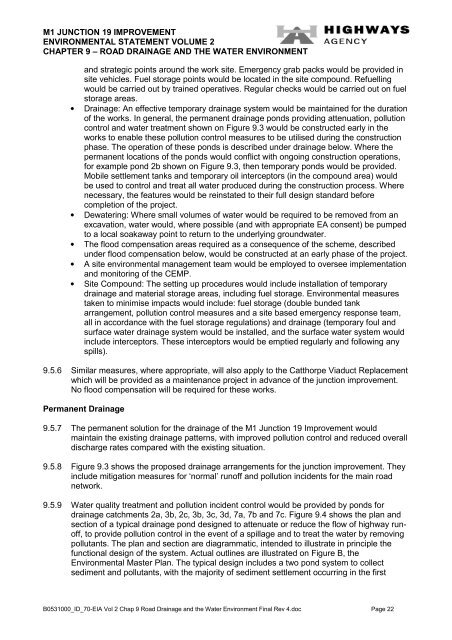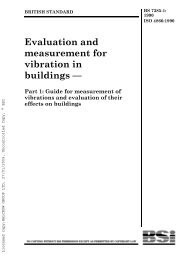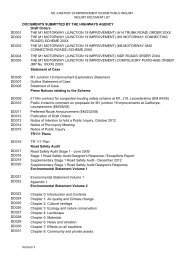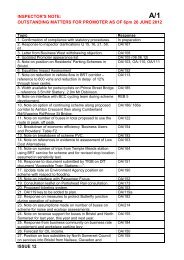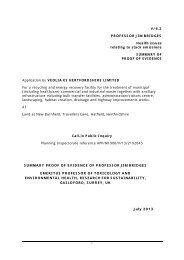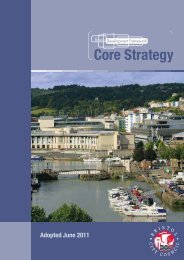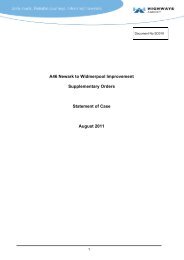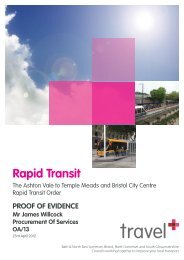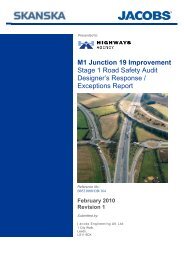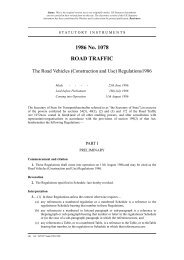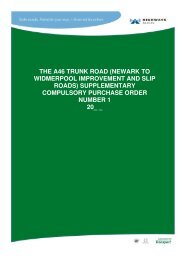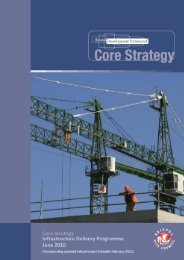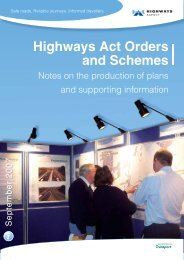Chapter 9: Road drainage and the water environment
Chapter 9: Road drainage and the water environment
Chapter 9: Road drainage and the water environment
You also want an ePaper? Increase the reach of your titles
YUMPU automatically turns print PDFs into web optimized ePapers that Google loves.
M1 JUNCTION 19 IMPROVEMENT<br />
ENVIRONMENTAL STATEMENT VOLUME 2<br />
CHAPTER 9 – ROAD DRAINAGE AND THE WATER ENVIRONMENT<br />
<strong>and</strong> strategic points around <strong>the</strong> work site. Emergency grab packs would be provided in<br />
site vehicles. Fuel storage points would be located in <strong>the</strong> site compound. Refuelling<br />
would be carried out by trained operatives. Regular checks would be carried out on fuel<br />
storage areas.<br />
• Drainage: An effective temporary <strong>drainage</strong> system would be maintained for <strong>the</strong> duration<br />
of <strong>the</strong> works. In general, <strong>the</strong> permanent <strong>drainage</strong> ponds providing attenuation, pollution<br />
control <strong>and</strong> <strong>water</strong> treatment shown on Figure 9.3 would be constructed early in <strong>the</strong><br />
works to enable <strong>the</strong>se pollution control measures to be utilised during <strong>the</strong> construction<br />
phase. The operation of <strong>the</strong>se ponds is described under <strong>drainage</strong> below. Where <strong>the</strong><br />
permanent locations of <strong>the</strong> ponds would conflict with ongoing construction operations,<br />
for example pond 2b shown on Figure 9.3, <strong>the</strong>n temporary ponds would be provided.<br />
Mobile settlement tanks <strong>and</strong> temporary oil interceptors (in <strong>the</strong> compound area) would<br />
be used to control <strong>and</strong> treat all <strong>water</strong> produced during <strong>the</strong> construction process. Where<br />
necessary, <strong>the</strong> features would be reinstated to <strong>the</strong>ir full design st<strong>and</strong>ard before<br />
completion of <strong>the</strong> project.<br />
• De<strong>water</strong>ing: Where small volumes of <strong>water</strong> would be required to be removed from an<br />
excavation, <strong>water</strong> would, where possible (<strong>and</strong> with appropriate EA consent) be pumped<br />
to a local soakaway point to return to <strong>the</strong> underlying ground<strong>water</strong>.<br />
• The flood compensation areas required as a consequence of <strong>the</strong> scheme, described<br />
under flood compensation below, would be constructed at an early phase of <strong>the</strong> project.<br />
• A site <strong>environment</strong>al management team would be employed to oversee implementation<br />
<strong>and</strong> monitoring of <strong>the</strong> CEMP.<br />
• Site Compound: The setting up procedures would include installation of temporary<br />
<strong>drainage</strong> <strong>and</strong> material storage areas, including fuel storage. Environmental measures<br />
taken to minimise impacts would include: fuel storage (double bunded tank<br />
arrangement, pollution control measures <strong>and</strong> a site based emergency response team,<br />
all in accordance with <strong>the</strong> fuel storage regulations) <strong>and</strong> <strong>drainage</strong> (temporary foul <strong>and</strong><br />
surface <strong>water</strong> <strong>drainage</strong> system would be installed, <strong>and</strong> <strong>the</strong> surface <strong>water</strong> system would<br />
include interceptors. These interceptors would be emptied regularly <strong>and</strong> following any<br />
spills).<br />
9.5.6 Similar measures, where appropriate, will also apply to <strong>the</strong> Catthorpe Viaduct Replacement<br />
which will be provided as a maintenance project in advance of <strong>the</strong> junction improvement.<br />
No flood compensation will be required for <strong>the</strong>se works.<br />
Permanent Drainage<br />
9.5.7 The permanent solution for <strong>the</strong> <strong>drainage</strong> of <strong>the</strong> M1 Junction 19 Improvement would<br />
maintain <strong>the</strong> existing <strong>drainage</strong> patterns, with improved pollution control <strong>and</strong> reduced overall<br />
discharge rates compared with <strong>the</strong> existing situation.<br />
9.5.8 Figure 9.3 shows <strong>the</strong> proposed <strong>drainage</strong> arrangements for <strong>the</strong> junction improvement. They<br />
include mitigation measures for ‘normal’ runoff <strong>and</strong> pollution incidents for <strong>the</strong> main road<br />
network.<br />
9.5.9 Water quality treatment <strong>and</strong> pollution incident control would be provided by ponds for<br />
<strong>drainage</strong> catchments 2a, 3b, 2c, 3b, 3c, 3d, 7a, 7b <strong>and</strong> 7c. Figure 9.4 shows <strong>the</strong> plan <strong>and</strong><br />
section of a typical <strong>drainage</strong> pond designed to attenuate or reduce <strong>the</strong> flow of highway runoff,<br />
to provide pollution control in <strong>the</strong> event of a spillage <strong>and</strong> to treat <strong>the</strong> <strong>water</strong> by removing<br />
pollutants. The plan <strong>and</strong> section are diagrammatic, intended to illustrate in principle <strong>the</strong><br />
functional design of <strong>the</strong> system. Actual outlines are illustrated on Figure B, <strong>the</strong><br />
Environmental Master Plan. The typical design includes a two pond system to collect<br />
sediment <strong>and</strong> pollutants, with <strong>the</strong> majority of sediment settlement occurring in <strong>the</strong> first<br />
B0531000_ID_70-EIA Vol 2 Chap 9 <strong>Road</strong> Drainage <strong>and</strong> <strong>the</strong> Water Environment Final Rev 4.doc Page 22


